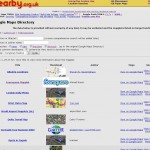Recently Google deprecated Mapplets, which are little applications that ran on Google Maps. They have also now removed the Google Maps Directory.
However its still possible to run mapplets by a dedicated page (well at least for as long as V2 of the Google Maps API exists) – but no listing of mapplets available within Google Maps.

But fear not, I captured a copy of the mapplet list, and created a small crawler to fetch the details from the mapplets, and present them in a little searchable application:
Admittedly the quality of the applications in the directory where always kinda variable, but there is some real gems in there, so at least preserving a listing I think is worthwhile, so they can be accessed if needbe.

